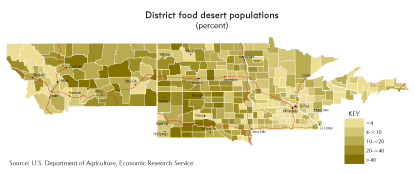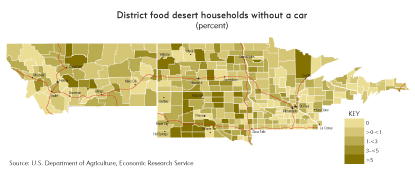
Obesity has gotten a great deal of attention from policymakers in recent years, and understandably so; over the past 30 years, the proportion of American adults who are obese (roughly, more than 20 percent over their ideal weight) has more than doubled.
Obesity is costly because the condition is linked to health problems such as heart disease and diabetes; the federal government’s Centers for Disease Control and Prevention has estimated that Americans spend as much as $147 billion annually on obesity-related medical care. The obesity epidemic is particularly acute among lower-income and less-educated households, and racial and ethnic minorities.
One reason put forward for the higher prevalence of obesity in low-income communities is a lack of ready access to healthy, low-calorie foods. Public health advocates have coined a term for this phenomenon: food deserts.
The intuition behind this idea is straightforward. In inner city neighborhoods and impoverished rural areas, grocery stores that sell fruits and vegetables, whole grain breads and low-fat dairy products are often few and far between. Distance is compounded by the fact that for many people in these areas, a trip to the supermarket is costly and time consuming. “Low-income people are often less mobile than higher-income people,” said economist Robert King, who directs the University of Minnesota’s Food Industry Center.
The notion of food deserts has prompted a deluge of research over the past 10 years on food access in poor communities. This research has mostly taken a case study approach, looking at low-income neighborhoods in the cores of individual cities and, to a far lesser extent, rural areas.
However, a recent report by the U.S. Department of Agriculture’s Economic Research Service studied the issue nationwide, in both urban and rural areas. The ERS report, commissioned by Congress as part of the 2008 farm bill and released last year, undertook a comprehensive analysis of the extent of food deserts and who lives in them.
An analysis of ERS data for the Ninth District shows that extensive areas qualify as food deserts according to the study’s criteria. These areas are home to only a small minority of district residents, but relative to the entire country, the proportion of district residents living in food deserts is roughly twice the national figure.
The ERS study has helped to put food deserts on the map, literally (see accompanying maps below). However, it’s still an open question whether people living in low-income areas distant from a grocery store really suffer “desert”-like lack of access to wholesome food. Moreover, because the connection between obesity and access to grocery stores is tenuous, the public policy implications of this issue are far from clear.
I’d walk a mile …
In its report, the ERS mostly eschews the term “food deserts” in favor of “areas with limited access to affordable and nutritious food.” This captures the idea that the issue is not simply limited availability of food—including highly caloric foods—but of healthy food. Indeed, several studies have found that low-income and minority neighborhoods on average have more fast food and convenience store options than higher-income areas.
The ERS analysis lays out specific criteria based on household income and distance to the nearest supermarket. Researchers identified low-income areas by looking at nationwide Census data on household income broken down into one-kilometer-square plots. An area qualifies as low income if over 40 percent of households have incomes less than twice the federal poverty level ($44,050 for a family of four). Low-income areas beyond a threshold distance from a supermarket are considered to have limited access.
The ERS provided the fedgazette with county-level data on the distribution of these areas in the district. Because driving to town to shop goes with the territory in farm country, the ERS study uses different criteria for rural as opposed to urban areas. District counties that are part of metropolitan statistical areas are classified as urban; those outside MSAs are considered rural.
In urban areas, the distance threshold for ready access to a supermarket is one mile—walking distance for most people. In auto-dependent rural areas, the cutoff is 10 miles. Low-income areas beyond these respective radiuses are categorized as food deserts in the study.
Nationwide, about 4 percent of the urban population lives in low-income, supermarket-free zones (although the typical low-income household actually lives closer to a grocery store than the corresponding higher-income household). In the district’s 42 metro counties, urban food deserts are more widespread than in the nation; 8 percent of city dwellers (over 350,000 people) live in such areas.
A little over 3 percent of rural residents nationwide live in low-income areas more than 10 miles from a grocery store. In rural counties in the district, the share of the population in that category is 8 percent, about the same as the metro figure, representing more than a quarter of a million people.
Living 10 miles from a grocery store is probably not an impediment for those with a reliable means of getting to one. But it can be a major problem for households that don’t own a car, especially in rural areas. The ERS report considers households without a vehicle as a subpopulation of special interest. The ERS analyzed data on vehicle ownership from the 2000 U.S. census to look at this issue.
It turns out that less than 2 percent of all U.S. urban households both lack a vehicle and reside more than a mile from a supermarket. The district figure is about the same. In rural areas, an even smaller proportion of households both lives more than 10 miles from a grocery store and has no vehicle—less than half of 1 percent nationally. But in the district, a much higher share of households far from supermarkets lacks wheels—about 1 percent, or roughly double the national figure.
These overall numbers obscure a great diversity among district counties. (See Tables 1 and 2 below for a list of counties at the top and at the bottom of the food-desert scale.) In 10 counties in the Dakotas and Montana (most home to Indian reservations), at least half of the population lives in low-income food deserts. In five of those counties, at least one in 10 households doesn’t own a car.
Table 1: Metro
| County | State | Total population | Households | Share of population >1 mile from super-markets that is low income | Share of housing units >1 mile from supermarkets without vehicle |
|---|---|---|---|---|---|
| McCook | SD | 5,827 | 2,202 | 30% | 5% |
| Turner | SD | 8,788 | 3,483 | 28% | 4% |
| Carbon | MT | 9,567 | 4,070 | 25% | 2% |
| St. Louis | MN | 200,085 | 82,435 | 17% | 6% |
| Carlton | MN | 31,925 | 12,164 | 16% | 3% |
| Ramsey | MN | 514,321 | 202,706 | 5% | 2% |
| Olmsted | MN | 123,792 | 47,628 | 5% | 1% |
| Dakota | MN | 352,101 | 129,763 | 5% | 1% |
| Cass | ND | 121,888 | 50,742 | 5% | 0% |
| Hennepin | MN | 1,111,944 | 454,593 | 4% | 2% |
Source: U.S. Department of Agriculture, Economic Research Service
Table 2: Rural
| County | State | Total population | Households | Share of population >1 mile from super-markets that is low income | Share of housing units >1 mile from supermarkets without vehicle |
|---|---|---|---|---|---|
| Shannon | SD | 12,511 | 2,794 | 69% | 14% |
| Jackson | SD | 2,922 | 942 | 68% | 7% |
| Corson | SD | 4,134 | 1,250 | 64% | 9% |
| Bennett | SD | 3,533 | 1,115 | 60% | 10% |
| Mellette | SD | 2,080 | 692 | 60% | 11% |
| Ziebach | SD | 2,450 | 721 | 59% | 11% |
| Petroleum | MT | 492 | 210 | 52% | 1% |
| Slope | ND | 760 | 310 | 51% | 0% |
| McPherson | SD | 2,932 | 1,236 | 50% | 10% |
| Wheatland | MT | 2,256 | 852 | 50% | 4% |
| Brown | MN | 26,624 | 10,495 | 1% | 0% |
| Nicollet | MN | 30,062 | 10,784 | 1% | 0% |
| Polk | WI | 41,144 | 16,185 | 1% | 0% |
| Silver Bow | MT | 34,601 | 14,433 | 0% | 0% |
| Winona | MN | 49,991 | 18,747 | 0% | 0% |
| Trempealeau | WI | 26,959 | 10,724 | 0% | 0% |
| Goodhue | MN | 44,039 | 16,909 | 0% | 0% |
| Le Sueur | MN | — | — | — | — |
| Rice | MN | — | — | — | — |
| Pepin | WI | — | — | — |
Source: U.S. Department of Agriculture, Economic Research Service
Just a mirage?
The ERS figures give a clear picture of the distribution of low-income areas without a supermarket nearby. However, it’s questionable whether such areas truly have limited access to affordable and nutritious food.
First, it’s worth taking a close look at what the data measure—and don’t measure. The ERS figures emphasize distance to large grocery stores because such stores reliably stock wholesome foods and typically charge less than convenience stores.
But distance is a proxy for limited access; measuring how far people must travel to buy nutritious foods doesn’t directly gauge access to such foods. The higher relative proportion of desert dwellers measured in the district by the ERS analysis is mostly due to the fact that, on average, people live farther from grocery stores in the region than in the nation as a whole. “In the north-central U.S., it’s probably mostly a population density issue,” said Michele Ver Ploeg, who directed the ERS study.
Similarly, income is a proxy for access, not a direct measure of whether people can obtain healthy food. Other studies of specific communities have looked at grocery prices, the quality and variety of food, or the ratio of fast food restaurants to produce vendors in an attempt to identify food deserts.
Especially in rural areas, focusing on distance from supermarkets and household income probably misses other sources of wholesome food, such as community gardens, backyard vegetable plots and farmers markets.
In counties with large American Indian reservations, many people are served by the federal Food Distribution Program on Indian Reservations. The ERS didn’t include the program’s food outlets in its analysis, but it is currently studying food access on reservations more closely.
The report may thus underestimate food access on reservations, although King said that “it’s probably still fair to consider them food deserts. You’ve got people spread out, you’ve got concentrations of low-income people, so you’ve got all the rural food-desert challenges.”
One final caution about the data is that they offer a snapshot in time, giving no indication of how the picture has changed over the years. Due to the proliferation of big-box grocery stores in rural areas, it could well be the case that food access has increased over time, and might increase further.
For these reasons, among others, the ERS report notes that “the current state of research is insufficient to determine whether some areas with limited access have inadequate access (emphasis added).”
Missing the oasis for the trees
There is a more fundamental question to ask about food deserts. If the primary concern is obesity and related health problems, how important is better access to food as an antidote to obesity?
The evidence is mixed. There does seem to be at least a slight correlation between distance to grocery stores and obesity rates. A 2009 review in the American Journal of Preventative Medicine found that areas near supermarkets tend to have lower rates of obesity, while those close to convenience stores tend to have higher rates. However, the study cautions that the underlying data on food access and nutritional levels are imperfect.
Moreover, the links in the chain connecting food availability to obesity are weak. A 2007 study in the economics journal Econometrica examined government programs that encouraged residents of low-income housing subsidies to move to new neighborhoods by offering them subsidies. The study suggests that “neighborhood effects,” like the influence of family and peers on eating habits, influence obesity more strongly than store availability.
Very few studies have looked directly at the effects of increased availability on nutrition. Two studies in the United Kingdom examined eating habits in neighborhoods that could be considered food deserts before and after a supermarket opened there. One study showed practically no change in diets, while the other study found that produce consumption increased slightly.
The link between eating the “right” foods and obesity is even more tenuous. In the voluminous literature on obesity, an overwhelming finding is that the single biggest contributing factor is high calorie intake, particularly from snack foods and sugary soft drinks. Intuitively, eating more fresh produce and vegetables implies less consumption of junk food. But it’s likely that people who eat more fruits and veggies are thinner because they’re health conscious and exercise more. Some studies have found that eating more “healthy” foods actually increases caloric intake and body weight.
So, lack of nutritious food “may be part of the problem for obesity,” Ver Ploeg said, “but obesity affects so many more people than just those who lack access [to healthier foods]. So it can’t be a major part of the story.”
Manna from government
Nevertheless, federal, state and local governments are experimenting with a host of programs intended to bring relief to perceived food deserts. These include support for local community gardens and farmers markets, and user subsidies for produce and other healthy foods, targeted at low-income families through the federal Supplemental Nutrition Assistance Program.
In September, the National Institutes of Health announced a $72.5 million research and prevention program focused on childhood obesity, which includes the creation of a research center at the University of Minnesota. One of the program’s efforts will be to expand access to healthy foods in existing stores.
In Pennsylvania, the state and local governments have intervened directly in retail food markets by offering block grants or low-interest loans to grocery operators to encourage them to open locations in low-income or thinly populated areas. A proposed $400 million federal program called the Healthy Food Financing Initiative would replicate such projects nationwide.
Even if greater access to supermarkets were deemed a worthy end in itself, there are probably better ways to increase access than giving stores a subsidy to locate in underserved areas. Ver Ploeg notes that providing transportation subsidies to low-income households to defray the cost of traveling to distant grocery stores would more directly address the problem of store access.
But if the primary concern is obesity, such policies might be beside the point. There are numerous alternative tools with which to tackle obesity. These include nutritional education for children and health insurance policies that give regular gym goers a break on their premiums. Taxes on junk food are more controversial, but they already exist in numerous states; in Minnesota, soft drinks, candy and snack foods (but not groceries) are subject to sales tax.
Overall, the problems of obesity and how to alleviate it are still poorly understood. Given this poverty of knowledge, policies that focus resources on putative food deserts might be putting the cart before the camel.
Joe Mahon is a Minneapolis Fed regional outreach director. Joe’s primary responsibilities involve tracking several sectors of the Ninth District economy, including agriculture, manufacturing, energy, and mining.







